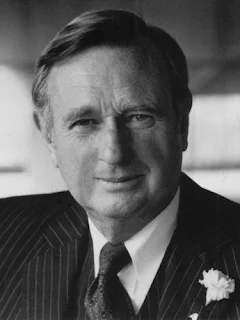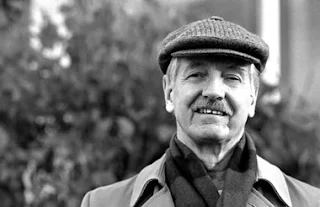Charles Harting Percy was an
American businessman and politician. He was president of the
Bell & Howell Corporation from 1949 to 1964. In 1966, he was elected to the
United States Senate from
Illinois as a
Republican; he served for almost twenty years, until 1985, after he was defeated by
Paul Simon. During his Senate career, he concentrated on business and foreign relations.
(September 27, 1919 – September 17, 2011)
Early life and education
Charles Harting Percy was born in
Pensacola, the seat of
Escambia County in far northwestern
Florida, the son of Edward H. Percy and the former Elisabeth Harting.
[4] His father, an
Alabama native descended from
Virginians, was at various times an automobile salesman and bank cashier. His Illinois-born mother was a
concert violinist. Edward was a son of Charles Brown Percy and Helen Leila Herndon, from the powerful Herndon family of
Virginia.
[5][6] Elizabeth Harting was a daughter of Phineas Fredrick Harting and Belle Aschenbach.
[7]
The family moved to
Chicago
when Percy was an infant. As a child, he was notable for his
entrepreneurial energy, and often held several jobs while attending
school. In the mid-1930s, his pluck brought him to the attention of his
Sunday school teacher, Joseph McNabb, the president of Bell & Howell, then a small
camera company.
Percy completed high school at
New Trier High School. He entered the
University of Chicago on a half tuition scholarship. He completed his degree in
economics in 1941.
[1][4]
Career
Percy started at Bell & Howell in 1938 as an apprentice and sales trainee. In 1939 he worked at
Crowell Collier. He went to work full time for Bell & Howell in 1941, after college. Within a year he was appointed a
director of the company. Percy served three years in the
United States Navy during
World War II and returned to the company in 1945.
[3]
After Joseph McNabb died in 1949, Percy was made the
president of Bell & Howell. In 1949, the
Jaycees named Percy one of the "Outstanding Young Men in America", along with
Gerald R. Ford, Jr., of
Michigan (future
U.S. President) and
John Ben Shepperd (future
Texas Attorney General.)
During his leadership of Bell & Howell, Percy led the company
through years of expansion, with a 32-fold increase in company sales, a
12-fold increase in employees, and taking the company public, with a
listing for stock sales on the
New York Stock Exchange.
While continuing to make a variety of movie cameras for military,
commercial and home use; and movie and sound projectors, in the late
1940s, the company branched into the production of
microfilm. Later it entered the information services markets as well.
Political career
In the late 1950s, Percy decided to enter politics. With the encouragement of then
U.S. President Dwight D. Eisenhower, Percy helped to write
Decisions for a Better America, which proposed a set of long-range goals for the Republican Party. He was considered to be a
liberal Republican, among a group from the
Northeast and
Midwest.
Percy first entered electoral politics with a run for
governor in 1964, which he narrowly lost to
Democratic incumbent
Otto Kerner. During his gubernatorial campaign, Percy reluctantly endorsed Republican
presidential nominee Barry Goldwater, his future Senate colleague, who fared poorly in Illinois.
U.S. Senate
In 1966, Percy ran for
senator from Illinois; he upset the Democratic senator
Paul Douglas
(a former professor of Percy's at the University of Chicago) with 56
percent of the vote. During that campaign, Percy's 21-year-old daughter
Valerie was murdered at the family home under mysterious circumstances,
apparently by an intruder. He suspended the campaign for two weeks.
Valerie Percy's murder has never been solved, despite a long
investigation.
[2] Following the murder,
CBS postponed, and eventually canceled, its planned airing of the
Alfred Hitchcock film
Psycho.
In 1967, Senator Percy introduced a bill to establish a program to stimulate production of
low-cost housing.
Percy's proposal was the first of its kind to provide home ownership to
low-income families, and it received strong support from Republicans in
both the House and the Senate. When asked why he selected housing for
his first major legislative proposal, Percy said: "Of all the problems I
ran across during three years of campaigning, first for the
governorship and then for the Senate, the most appalling in their
consequences for the future seemed to be the problems of the declining
areas of the city and countryside, the inadequacy of housing."
In 1978, as Percy was completing his second term, he appeared invincible.
[8] Percy was considered so strong that the Democratic party was unable to persuade any serious candidates to challenge him.
[9] Emerging from the Democratic primary was the
dark horse candidate,
Alex Seith, who had never before sought elected office but had served as an appointee on the
Cook County Zoning Board of Appeals for twelve years, nine as chairman.
But at that time, Percy's reputation as a
Rockefeller Republican, contrasted with Seith's ostensible hard-line
foreign policy
positions, combined to make Percy suddenly vulnerable in the weeks
before the election. Sensing his improbable loss, Percy went on
television days before the polling and, with tear-filled eyes, pleaded
with Illinois voters to give him another chance. He said, "I got your
message and you're right . . . I'm sure that I've made my share of
mistakes, but your priorities are mine."
[10] He won re-election by a 54% to 46% margin.
Percy served in the Senate until the end of his third term in January 1985. He had been narrowly defeated for
re-election in November 1984 by the liberal Congressman
Paul Simon. After Percy's defeat, no Republican would win a senatorial race in Illinois until
Peter Fitzgerald in 1998.
In 2006, in writing about the influence of political lobbies on the U.S. relationship with
Israel, political theorists
John Mearsheimer and
Stephen Walt wrote that they believed Percy's loss resulted from the campaign waged against him by the powerful
American Israel Public Affairs Committee (
AIPAC).
[11]
The lobbying group controlled substantial monies and helped lawmakers
who they believed supported the security of Israel. Earlier that year,
Percy had addressed himself, along with the chairman of the House
Foreign Affairs Committee,
Dante Fascell, to the cause of
Karl Linnas,
a concentration camp commander who was to be deported back to Estonia,
having lied in the papers he used to enter the United States. Linnas had
ordered, and participated in, the murders of Jews and other prisoners.
[12] Percy's view, shared by Fascell and by Representative
Donald L. Ritter of Pennsylvania and of the
Helsinki Commission was that Linnas should be deported but not to the Soviet Union.
While in the Senate, Percy was active in the areas of business and
international affairs. Although he explored the possibility of running
for President in 1968 and 1976, he did not run either time. During the
early 1970s, he clashed with the policies of President Nixon and
criticized the U.S. conduct of the
Vietnam War.
In 1977, Percy and Sen.
Hubert H. Humphrey - responding to the 1973 OPEC oil embargo and high energy prices in general - created the
Alliance to Save Energy[13] to encourage a national commitment to energy efficiency. Sen. Percy was the founding chairman of the organization.
[14]
Perhaps Percy's most important act, and his longest-lasting legacy, was ending the practice of nominating
federal judges
from the Chicago political machine. He implemented a system of
consultation with, and advice from, several groups, including the
professional bar association, which was considered novel at the time.
[15] One of his nominees,
John Paul Stevens, was selected by Gerald Ford as a justice of the
United States Supreme Court.
[15]
Literary opinions
Percy said of the
Autobiography of Malcolm X, that "Every white person should read it."
[16]
Marriage and family
Percy was a
Christian Scientist.
[4] During World War II, Percy married Jeanne Dickerson. They had twin daughters, Valerie and
Sharon
(born 1944), and a son Roger (born 1947). Jeanne died in 1947, of a
violent reaction to drugs after a seemingly simple and successful
operation. In 1950, Percy married Loraine Guyer. Their children were
Gail (born 1953) and Mark (born 1955).
About a year after the murder of her twin sister Valerie, in 1966, Sharon Percy married
John D. Rockefeller IV,
[4] who was later elected to two terms (1977-1985) as the Democratic
Governor of West Virginia and has been a
United States Senator from that state since 1985.
He remained active after leaving political office, but suffered from
Alzheimer's disease in his later years.
[17]
He died on September 17, 2011 at the Washington Home and Community Hospice in
Washington, D.C..
[4][18]
To see more of who died in 2011
click here
 George Benton was a boxer and a boxing trainer from Philadelphia, Pennsylvania.
George Benton was a boxer and a boxing trainer from Philadelphia, Pennsylvania.


















